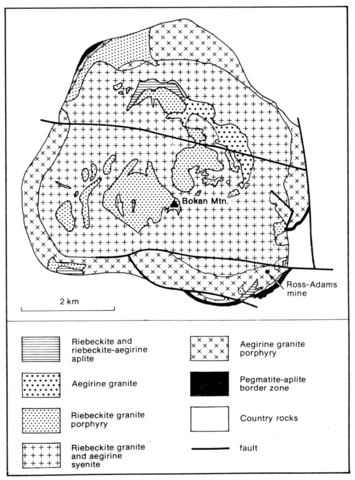stripes
Located near the southern end of Prince of Wales Island, Bokan is a complex of peralkaline granites, syenites and aplites covering 28. 5 km2, emplaced into graphitic slates in the south and west and metavolcanics and non-alkaline plutonic rocks elsewhere. The complex appears to involve a system of ring dykes, twelve intrusive episodes having been distinguished by Thompson et al. (1982). A discontinuous border zone of pegmatite/aplite with aegirine and riebeckite is up to 13 m thick, and succeeded inwards by aegirine granite porphyry which develops an almost continuous ring around the complex. Four varieties are distinguishable, mainly on textural grounds. The inner contact is a transition zone, up to 15 m thick, to riebeckite granite in which there are porphyritic and aplitic variants. There is also a small area of aegirine-quartz syenite within this group which is principally encountered in mine workings. Riebeckite granite porphyry is the principal rock type in the central area, the riebeckite being flow orientated and concentrated into bands 0 1-1 cm in width. Later intrusions of riebeckite and aegirine granite and riebeckite-aegirine aplite can be distinguished. There are some minor lamprophyric and andesitic dykes within the complex. Major and trace element data for whole rocks are given by Thompson et al. (1982).
ARMSTRONG, R.L. 1985. Rb-Sr dating of the Bokan Mountain granite complex and its country rocks. Canadian Journal of Earth Sciences, 22: 1233-6.
MACKEVETT, E.M. Jr., 1963. Geology and ore deposits of the Bokan Mountain uranium-thorium area, southeastern Alaska. Bulletin, United States Geological Survey, 1154: 1-125.
SAINT-ANDRE, B. de, LANCELOT, J.R. and COLLOT, B. 1982. U-Pb geochronology of the Bokan Mountain peralkaline granite, southeastern Alaska. Canadian Journal of Earth Sciences, 20: 236-45.
STAATZ, M.H. 1978. I and L uranium and thorium vein system, Bokan Mountain, southeastern Alaska. Economic Geology, 73: 512-23.
THOMPSON, T.B., PIERSON, J.R. and LYTTLE, T. 1982. Petrology and petrogenesis of the Bokan granite complex, southeastern Alaska. Bulletin of the Geological Society of America, 93: 898-908

